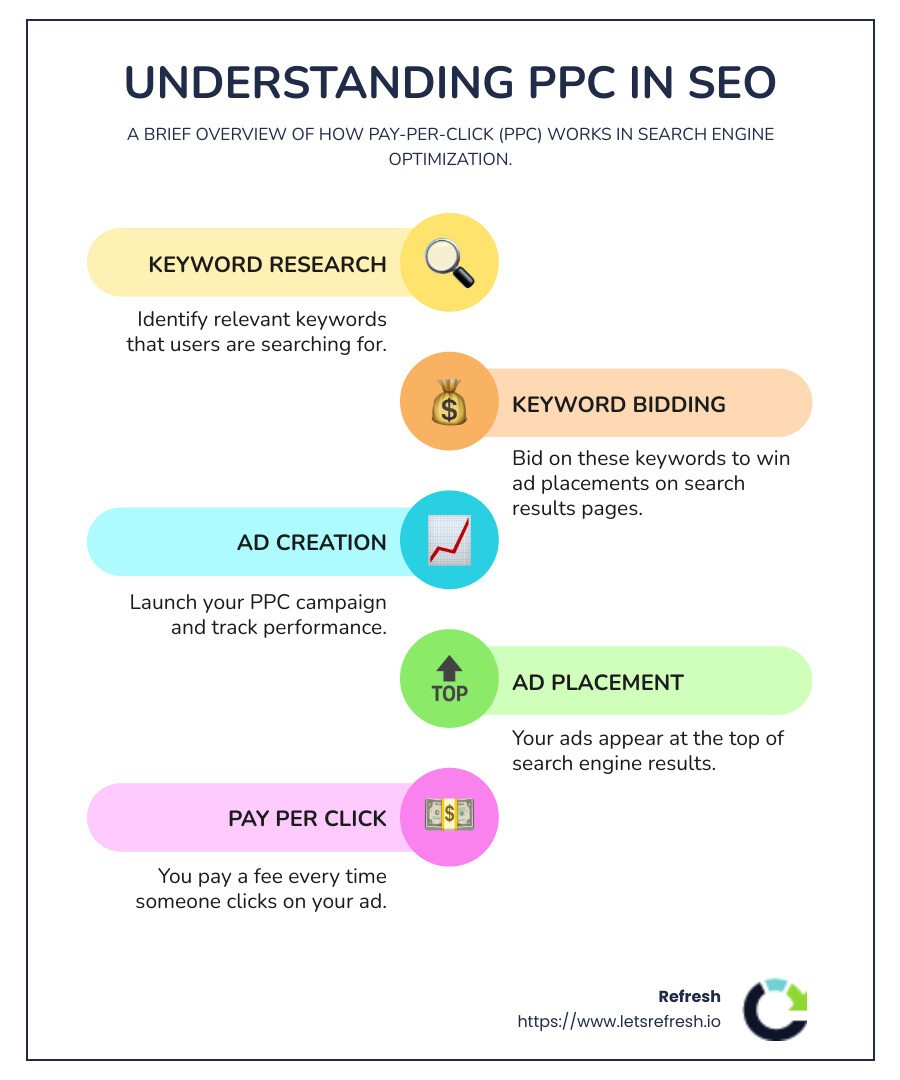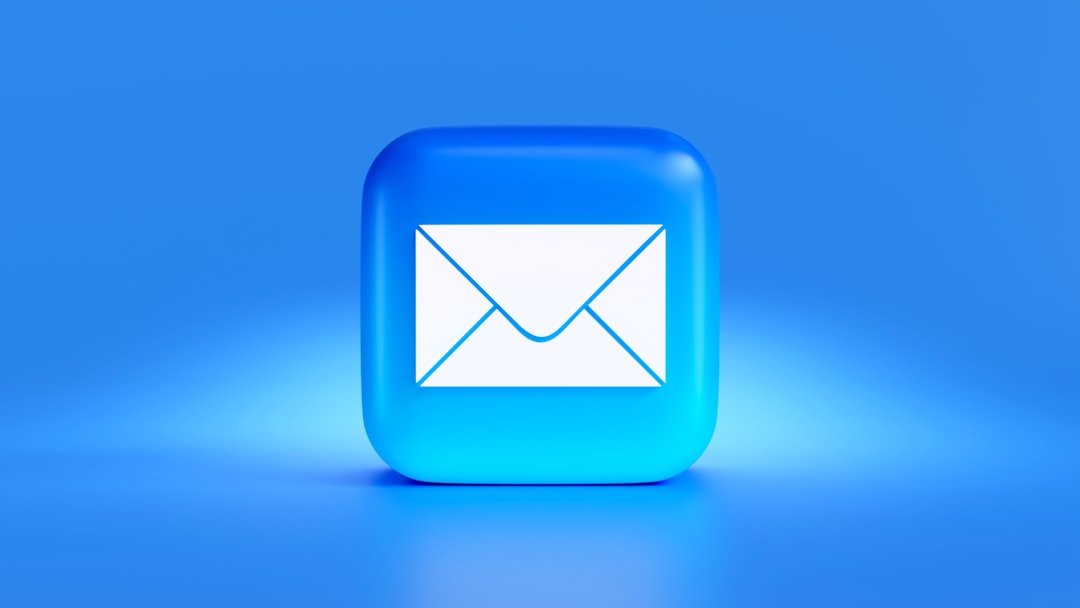July 24, 2025
How to Generate Traffic and Achieve Online Business Success
PPC SEO meaning can be confusing, but understanding it can greatly improve your online business. Here's a quick overview:
- SEO (Search Engine Optimization):
- Focuses on organic traffic
- Involves on-page, off-page, and technical optimizations
- PPC (Pay-Per-Click):
- Involves paid advertising
- You pay for clicks generated from ads placed on search engines
Generating traffic is essential for any online business's success, serving as its lifeblood. Two primary methods to achieve this are SEO (Search Engine Optimization) and PPC (Pay-Per-Click). Both can drive traffic to your website, but they accomplish this in very different ways.
Think of SEO as establishing a long-term presence by optimizing your content to rank high in search results organically. It’s like planting seeds and waiting for them to grow into a fruitful tree. On the other hand, PPC is about paying for immediate visibility, similar to renting a billboard in a prime location. Both methods have their unique advantages and challenges, and knowing when to use each can make a significant difference.
At Refresh, we're committed to helping businesses steer these complexities. As the founder and CEO, I have helped many companies improve their digital strategies through an effective blend of SEO and PPC.

What Is SEO?
SEO, or Search Engine Optimization, aims to increase your website's visibility in organic (unpaid) search engine results. By optimizing various elements on and off your site, you can attract more traffic without paying for ads.
Here's a closer look at the key elements of SEO:
Keyword Research
Keyword research is the process of identifying the terms and phrases people use when searching for information. These keywords are the foundation of your SEO strategy.
Using tools like our Keyword Magic Tool, you can find high-value keywords that align with your business. Look for keywords with high search volume and low competition. This can help you attract users who are interested in your products or services.
Types of Keywords:- Navigational: People looking for a specific website.- Informational: Users seeking knowledge.- Commercial: Potential buyers researching products.- Transactional: Ready-to-buy customers.
On-Page SEO
On-page SEO involves optimizing individual webpages to rank higher and earn more relevant traffic. This includes:
- Content Creation: Develop informative or entertaining materials for your audience.
- Keyword Placement: Strategically place keywords in titles, headers, and throughout the content.
- Title Optimization: Create compelling, keyword-rich titles.
- URL Structure: Use straightforward and descriptive URLs.
- Image Optimization: Use alt text and compress images for faster loading times.
For example, if you're targeting "beginner's guide to yoga," a long-form blog post would be ideal. But for "yoga poses for beginners," a video demonstrating the poses would be more effective.
Off-Page SEO
Off-page SEO involves activities outside your website to improve its ranking. This includes:
- Backlinks: Links from other sites pointing to yours.
- Link Building: Actively seeking backlinks from reputable sites.
- Reviews and Citations: Especially important for local SEO.
These activities signal to search engines that your site is credible. For instance, getting a backlink from a high-authority site can significantly boost your rankings.
Technical SEO
Technical SEO focuses on the backend of your website. It ensures that search engines can find, crawl, and index your content. Key elements include:
- Crawlability and Indexing: Make sure search engines can easily crawl and index your site.
- Site Speed: Fast-loading sites rank better.
- Mobile-Friendliness: Ensure your site is optimized for mobile devices.
Using tools like our Site Audit tool, you can identify and fix technical issues that might be holding your site back.
Next, we'll dive into PPC (Pay-Per-Click), another powerful method to drive traffic to your website.
What is PPC?
PPC, or Pay-Per-Click, is a paid advertising model where you pay a fee each time someone clicks on your ad. This method offers immediate visibility and traffic, making it ideal for lead generation and sales campaigns. Let's break down the key components of PPC:
Keyword Research for PPC
Keyword research in PPC is crucial for targeting the right audience. You want to choose keywords that are:
- Highly relevant to your ads and landing pages.
- Have enough search volume to drive traffic.
- Not overly competitive to keep costs manageable.
Use tools like the Keyword Magic Tool to research search volumes and get keyword suggestions. Look for keywords that match your campaign’s goals. For instance, if you're aiming to drive sales, opt for transactional keywords.
Audience Targeting
Effective audience targeting helps place your ads in front of people most likely to be interested in them. You can target based on:
- Demographics: Age, income level, education, etc.
- Geographics: Country, city, or specific location radius.
- Interests: Preferences, hobbies, and behaviors.
Using these criteria, you can optimize your budget and increase the chances of attracting the right audience. Tools like Semrush’s One2Target can help you understand your competitors' audience demographics and behaviors.
Ad Creation and Quality Score
Ad creation involves crafting compelling ad copy that conveys your message, matches search intent, and encourages action. Key elements include:
- Conveying your message: Clearly state what you're offering and its value.
- Matching search intent: Align your ad with what the user is looking for.
- Encouraging action: Include a strong call-to-action (CTA).
Your ad copy must be concise due to character limits (e.g., 30 characters for headlines, 90 characters for descriptions).
Quality Score is a metric used by Google Ads to evaluate the quality and relevance of your ads. A higher Quality Score can lead to better ad positions and lower costs per click (CPC). Factors influencing Quality Score include:
- Relevance of your keywords, ad copy, and landing pages.
- Click-through rate (CTR): How often users click on your ad.
- Landing page experience: How well your landing page meets user expectations.
By optimizing these elements, you can improve your ad performance and achieve better results.
Next, we'll explore the Pros and Cons of SEO, and how it compares to PPC.
Pros and Cons of SEO
Pros of SEO
1. Long-term Results
SEO provides long-term benefits. Once your site ranks well, it can stay there with consistent effort. Unlike PPC, where traffic stops when you stop paying, SEO can keep delivering traffic without ongoing costs.
2. Brand Authority
Ranking high in search engines boosts your brand authority. People trust organic results more than paid ads. When your site appears at the top, it signals to users that your brand is credible and trustworthy.

3. Cost-Effectiveness
SEO can be more cost-effective in the long run. While there are upfront costs for content creation and optimization, you don’t pay for each click. Over time, this organic traffic can provide a higher return on investment compared to PPC.
4. Consistent Traffic
Once your pages rank, they can bring in consistent traffic. Unlike PPC, where traffic can fluctuate based on budget and bidding, SEO offers more stability.
5. Scalability
SEO is highly scalable. As your site grows, you can target more keywords and expand your reach. This can lead to more traffic and opportunities for conversions.
Cons of SEO
1. Time-Consuming
SEO is time-consuming. It can take months to see significant results. As a former Google employee mentioned, it can take four to 12 months to see an impact. This makes it less ideal for businesses needing quick wins.
2. Algorithm Changes
Search engines frequently update their algorithms. This means you need to stay updated and adjust your strategies. These changes can affect your rankings, sometimes unpredictably.
3. Ongoing Optimization
SEO requires ongoing optimization. You must continuously update your content, build backlinks, and monitor your site’s performance. This can be demanding, especially for businesses with limited resources.
Next, we'll explore the Pros and Cons of PPC, giving you a complete picture to make an informed decision.
Pros and Cons of PPC
Pros of PPC
1. Immediate Results
One of the biggest advantages of PPC is immediate results. As soon as you launch your campaign, your ads can start driving traffic. This is perfect for product launches or time-sensitive promotions.
2. Targeted Ads
PPC allows for laser-focused targeting. You can target your audience by demographics, geography, interests, and even previous interactions with your site. This precision ensures your ads reach the right people.
3. Quick Results
With PPC, you can quickly see what works. You get instant feedback on your campaigns, allowing for rapid adjustments. This is ideal for testing new products or marketing messages.
4. A/B Testing
PPC platforms offer robust A/B testing features. You can test different ad copies, headlines, and images to see which performs better. This helps optimize your campaigns for maximum effectiveness.
5. Budget Control
PPC provides flexible budget control. You can set daily or monthly limits to ensure you don’t overspend. This makes it easier to manage your advertising costs.
Cons of PPC
1. Expensive
PPC can get expensive quickly, especially in competitive industries. Keywords like “car insurance” can cost up to $40 per click. This can strain your budget if not managed carefully.
2. Lower Profit Margins
Due to the high costs, PPC often results in lower profit margins. You need to ensure that the revenue generated from your ads justifies the expenditure.
3. Ad Fatigue
Over time, users may experience ad fatigue. This happens when they see your ads too often, causing them to become less effective. Frequent updates and new creatives are needed to keep your ads fresh.
4. Constant Investment
PPC requires constant investment. Unlike SEO, where traffic continues even without ongoing effort, PPC traffic stops the moment you stop paying. This means you need a continuous budget to maintain results.
Next, we'll explore When to Use SEO vs. PPC, helping you decide which strategy aligns best with your business needs.
When to Use SEO vs. PPC
Choosing between SEO and PPC depends on your business goals, budget, and timeline. Here’s a guide to help you decide when to use each strategy.
Use SEO If...
1. You Have a Low Budget
SEO is a cost-effective way to drive traffic. Unlike PPC, you don’t pay for each click. Instead, you invest in creating quality content and optimizing your site. Over time, this can yield significant returns without constant spending.
2. You Aim for Long-Term ROI
SEO is great for long-term growth. Once your pages rank high, they can continue to attract traffic for months or even years with minimal maintenance. This makes SEO ideal if you’re playing the long game and want sustainable results.
3. You Want to Build Brand Authority
High search engine rankings can boost your brand’s credibility. Users tend to trust organic results more than ads. By consistently providing valuable content, you can establish your brand as an authority in your industry.
4. You Focus on Content Marketing
SEO and content marketing go hand-in-hand. By creating informative and engaging content, you can attract visitors looking for answers. This not only improves your rankings but also helps build a loyal audience.
Use PPC If...
1. You Need Quick Results
If you need immediate visibility, PPC is the way to go. As soon as you launch your campaign, your ads can start appearing in search results. This is perfect for product launches or time-sensitive promotions.
2. You’re Running Time-Sensitive Offers
PPC is ideal for limited-time offers or events. For example, if you’re promoting a Black Friday sale, PPC can help you get the word out quickly and drive immediate traffic.
3. You Want Targeted Traffic
PPC allows for precise targeting. You can show your ads to specific demographics, locations, and even based on user behavior. This ensures your ads reach the right audience, increasing the likelihood of conversions.
4. You Have a Budget for Advertising
PPC requires a continuous budget. Unlike SEO, which can sustain itself over time, PPC traffic stops once you stop paying. This makes PPC suitable if you have the funds to maintain ongoing campaigns.
5. You’re Testing Marketing Strategies
PPC provides real-time feedback, making it perfect for testing new strategies. You can quickly see what works and what doesn’t, allowing you to refine your approach before committing to long-term SEO efforts.
In summary, use SEO for sustainable, long-term growth, brand authority, and when you have a limited budget. Opt for PPC for quick results, precise targeting, and time-sensitive campaigns.
Next, we’ll discuss How to Integrate SEO and PPC to maximize your marketing efforts.
How to Integrate SEO and PPC
Combining SEO and PPC strategies can provide a powerful boost to your marketing efforts. Here's how you can integrate these two approaches to maximize results.
Retargeting Ads
Retargeting is a fantastic way to bring back visitors who have left your site without converting. Here’s how it works:
- Visitor Tracking: When someone visits your website, a cookie is placed in their browser.
- Ad Display: As they browse other sites, your ads appear, reminding them of your offerings.
- Conversion Optimization: By showing targeted ads to these visitors, you increase the chances of converting them into customers.
For example, a visitor who reads a blog post about eco-friendly shampoos might later see ads for your product on social media, prompting them to make a purchase.
Promoting Content with PPC
Creating high-quality content is time-consuming, and you want to ensure it reaches a broad audience. Promote your content using PPC ads on platforms like Facebook, Twitter, and Quora. This boosts visibility and drives traffic quickly.
Social Media Ads: Use platforms where your target audience is active. For instance, B2C businesses might find success on Instagram and Facebook.
Content Distribution: Run ads to distribute your blog posts, videos, and other content to a wider audience. This not only increases traffic but also helps in building backlinks, which improves your SEO.
Using PPC Data for SEO
PPC campaigns can provide valuable data that you can use to improve your SEO efforts.
- Keyword Insights: Analyze which keywords perform well in your PPC campaigns. These keywords can then be targeted in your SEO strategy to attract organic traffic.
- Conversion Data: Identify which ads and keywords lead to the most conversions. Use this data to optimize your content and on-page SEO.
- Competitor Analysis: Tools like Ahrefs and Semrush can show you the keywords your competitors are bidding on. This information helps you understand market trends and identify new opportunities for both SEO and PPC.
By using PPC data to inform your SEO strategy, you can create a more comprehensive and efficient marketing approach.
Integrating SEO and PPC allows you to leverage the strengths of both strategies. Retargeting ads can bring back potential customers, promoting content with PPC can amplify your reach, and using PPC data can refine your SEO efforts. This combined strategy ensures you get the best of both worlds, driving both immediate and long-term results.
Next, we’ll dive into Frequently Asked Questions about PPC SEO Meaning to clear any remaining doubts you may have.
Frequently Asked Questions about PPC SEO Meaning
What is PPC in SEO?
PPC (Pay-Per-Click) in SEO refers to paid advertising strategies that place your ads at the top of search engine results pages (SERPs). When you run a Google Ads campaign, you bid on specific keywords. If your bid wins, your ad appears in the paid search results for those keywords. You pay a fee every time someone clicks on your ad.

What is the difference between SEO and PPC?
SEO (Search Engine Optimization) and PPC are two different strategies for driving traffic to your website.
- SEO focuses on improving your website to rank higher in organic search results. This involves optimizing your content, earning backlinks, and ensuring your site is technically sound. The goal is to attract organic traffic without paying for each click.
- PPC, on the other hand, is a paid strategy where you bid on keywords to have your ads displayed in the paid search results. You pay each time someone clicks on your ad, hence "Pay-Per-Click."
FeatureSEOPPCCostFree clicks, but time-intensivePay per clickTrafficOrganicPaidTimeframeLong-termShort-termClicksTrustworthy and credibleImmediate, but costly
How do SEO and PPC work together?
Combining SEO and PPC can create a powerful marketing strategy that leverages the strengths of both approaches.
- Data Sharing: Use data from your PPC campaigns to inform your SEO strategy. For example, if certain keywords perform well in PPC, you can target them in your SEO efforts to attract organic traffic.
- Comprehensive Marketing: While SEO builds long-term brand authority and trust, PPC can drive immediate traffic and conversions. This dual approach ensures that you capture both short-term and long-term opportunities.
- Retargeting: Use PPC to retarget visitors who found you through SEO but didn’t convert. This keeps your brand top-of-mind and encourages them to return and make a purchase.
- Content Promotion: Promote your high-quality content through PPC to give it an initial boost. This can help you gain visibility and attract backlinks, which in turn, benefits your SEO.
By integrating SEO and PPC, you can create a more effective and efficient marketing strategy that maximizes your reach and return on investment.
Next, we’ll dive into Conclusion to wrap up our insights and provide actionable steps for integrating these strategies into your digital marketing plan.
Conclusion
At Refresh, we believe in the power of an integrated approach to digital marketing. Combining SEO and PPC allows us to leverage the strengths of both strategies for long-term success.
Refresh: Your Partner in Digital Success
SEO builds a solid foundation by improving your website's organic search rankings. This attracts consistent, high-quality traffic over time. On the other hand, PPC provides quick, targeted visibility, driving immediate results when you need them most.
Integrated Approach for Long-Term Success
By using both SEO and PPC, we create a balanced strategy that delivers both short-term wins and long-term growth. Here's how we do it:
- Data Sharing: Insights from PPC campaigns help refine our SEO strategies. For instance, high-performing PPC keywords can become focal points in our SEO efforts.
- Comprehensive Marketing: While SEO builds your brand's authority and trust, PPC ensures you're capturing immediate opportunities. This dual approach means you're always visible, whether users are searching organically or through paid ads.
- Retargeting: We use PPC to retarget visitors who found you through SEO but didn't convert. This keeps your brand top-of-mind and encourages repeat visits and conversions.
- Content Promotion: Our high-quality content gets an initial boost through PPC. This not only drives traffic but also helps gain backlinks, benefiting your SEO in the long run.
Achieve Digital Marketing Success with Refresh
By embracing both SEO and PPC, you can maximize your reach and return on investment. Ready to lift your digital presence? Contact us today to learn how Refresh can drive results for your business.
By leveraging the combined power of SEO and PPC, we help you achieve unparalleled growth and long-term success. Let's make your success story unfold together.
If you have any questions or need further guidance, reach out. We're here to help you steer the digital marketing landscape and achieve your goals.
Still have questions? Let’s talk about it.
.avif)





